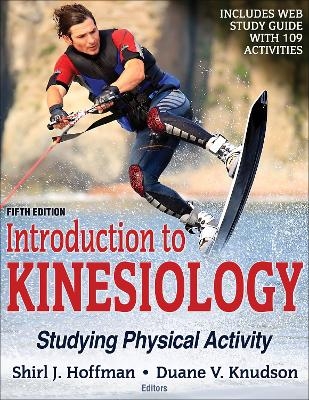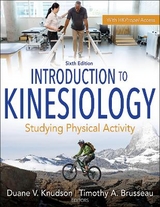
Introduction to Kinesiology 5th Edition With Web Study Guide
Human Kinetics (Verlag)
978-1-4925-4992-5 (ISBN)
- Titel erscheint in neuer Auflage
- Artikel merken
The fifth edition features a completely revitalized web study guide that encourages students to apply classroom content to real-world activities and better prepare for exams. The web study guide integrates reading assignments with gradable activities so that instructors can better monitor student progress, test understanding of key concepts, and adjust classroom discussions and pace.
Additional updates to this new fifth edition include the following:
- Updates to data, research, and graphics to incorporate the most recent discoveries
- An increased focus on public health, allied health, and nutrition and wellness to reflect changes in this dynamic and growing field
- New Professional Issues in Kinesiology sidebars that look at the issues of equality, evidence-based practice, expertise, and overload as they relate to the field of kinesiology
- New Kinesiology Colleagues sidebars that introduce role models who demonstrate professional life in kinesiology and its related fields
The text features the three-section structure that has always been a strength of this leading introductory textbook. Part I examines the diversity of physical activity and kinesiology and summarizes the importance of knowledge gained through physical activity experiences. Part II delves into the seven major subdisciplines of kinesiology, with an overview of major historical events, research methods, professional work and application, and ideas for career advancement in each. Part III elaborates on professionalism and then examines five main areas for career opportunities.
The extensive and revitalized instructor ancillaries include an instructor guide, a test package, chapter quizzes, a presentation package, and an image bank that includes most art and tables from the text.
Introduction to Kinesiology provides basic and essential information for students embarking on their study of kinesiology, and this updated fifth edition prepares them for future courses and further study.
Shirl J. Hoffman, EdD, is a professor emeritus of exercise and sport science at the University of North Carolina at Greensboro, where he served as department head for 10 years. He has served at many levels of education: as an elementary physical education teacher, as a college-level coach, and as a professor in both research university and liberal arts college settings. Hoffman has published extensively on a variety of topics, including sport philosophy and ethics, religion in sport, qualitative analysis and diagnosis of movement, and motor learning and performance. Hoffman is the author of Good Game: Christianity and the Culture of Sport (2010) and was the project coordinator for Careers in Sport, Fitness, and Exercise (2011), published by the American Kinesiology Association. He has also been a frequent commentator on issues in kinesiology and higher education. Hoffman is a former editor of Quest and was the charter executive director of the American Kinesiology Association (AKA). He is a fellow emeritus of the National Academy of Kinesiology (NAK). Hoffman and his wife, Claude, reside in Greensboro, North Carolina, and Boone, North Carolina. Duane V. Knudson, PhD, is a professor of biomechanics in the department of health and human performance at Texas State University. He earned his doctorate at the University of Wisconsin and has held tenured positions at three universities. Knudson's research areas are the biomechanics of tennis, stretching, qualitative movement diagnosis, and learning biomechanical concepts. He has authored more than 130 peer-reviewed articles and 14 chapters. Knudson is the author of Biomechanical Principles of Tennis Technique (2006), Fundamentals of Biomechanics, Second Edition (2007), and Qualitative Diagnosis of Human Movement, Third Edition (2013). He has received numerous regional, state, national, and international awards for his scholarship and has been elected a fellow of three scholarly societies. He has served as a department chair, as an associate dean, as president of the American Kinesiology Association, as vice president of publications for the International Society of Biomechanics in Sports, and in numerous other professional leadership roles.
Chapter 1. Introduction to Kinesiology Duane V. Knudson and Shirl J. Hoffman Interest in the Discipline of Kinesiology Physical Activity: The Focus of Kinesiology Some Focuses of Physical Activity in Kinesiology Wrap-Up Part I: Experiencing Physical Activity Chapter 2. Spheres of Physical Activity Experience Shirl J. Hoffman Sphere of Self-Sufficiency Sphere of Self-Expression Sphere of Work Sphere of Education Sphere of Leisure Sphere of Health Sphere of Competition Wrap-Up Chapter 3. The Importance of Physical Activity Experiences Duane V. Knudson Physical Activity as a Signature of Humanity Factors That Influence the Kinds of Experience in Physical Activity Ways in Which Experience Can Affect Physical Activity Identifying Critical Components of a Physical Activity Heredity and Experience Subjective Experience of Physical Activity Why Subjective Experiences Are Important to Kinesiology Professionals Components of Subjective Experience Factors Affecting Our Enjoyment of Physical Activity Watching Sport as a Subjective Experience Wrap-Up Part II: Scholarly Study of Physical Activity Chapter 4. Philosophy of Physical Activity Scott Kretchmar and Cesar R. Torres Why Use Philosophical Thinking? What Do Philosophers Do? History of Philosophy of Physical Activity Research Methods for Philosophy of Physical Activity Overview of Knowledge in Philosophy of Physical Activity Wrap-Up Chapter 5. History of Physical Activity Richard A. Swanson Why Use History of Physical Activity? What Do Historians of Physical Activity Do? History of Kinesiology and Physical Activity Research Methods for History of Physical Activity Overview of Knowledge in History of Physical Activity Wrap-Up Chapter 6. Sociology of Physical Activity Katherine M. Jamieson Why Use Sociology of Physical Activity? What Do Sociologists of Physical Activity Do? History of Sociology of Physical Activity Research Methods for Sociology of Physical Activity Overview of Knowledge in Sociology of Physical Activity Wrap-Up Chapter 7. Motor Behavior Katherine T. Thomas and Jerry R. Thomas Why Use Motor Behavior? What Do Motor Behaviorists Do? History of Motor Behavior Research Methods for Motor Behavior Overview of Knowledge in Motor Behavior Wrap-Up Chapter 8. Sport and Exercise Psychology Robin S. Vealey Why Use Sport and Exercise Psychology? What Do Sport and Exercise Psychology Professionals Do? History of Sport and Exercise Psychology Research Methods for Sport and Exercise Psychology Overview of Knowledge in Sport and Exercise Psychology Wrap-Up Chapter 9. Biomechanics of Physical Activity Kathy Simpson Why Use Biomechanics of Physical Activity? What Do Biomechanists Do? History of Biomechanics Research Methods for Biomechanics Overview of Knowledge in Biomechanics Wrap-Up Chapter 10. Physiology of Physical Activity Jennifer L. Caputo Why Use Physiology of Physical Activity? What Do Exercise Physiologists Do? History of Physiology of Physical Activity Research Methods for Physiology of Physical Activity Overview of Knowledge in Physiology of Physical Activity Wrap-Up Part III: Practicing a Profession in Physical Activity Chapter 11. Becoming a Physical Activity Professional Shirl J. Hoffman What Is a Profession? How Do Our Values Shape Our Professional Conduct? How Are Physical Activity Professionals Educated for the Workforce? Are You Suited for a Career in the Physical Activity Professions? Wrap-Up Chapter 12. Careers in Health and Fitness Warren D. Franke What Is the Health and Fitness Profession? Settings for Health and Fitness Roles for Health and Fitness Professionals Trends and Opportunities in Health and Fitness Advice for Health and Fitness Students Wrap-Up Chapter 13. Careers in Therapeutic Exercise Chad Starkey What Is Therapeutic Exercise? Settings for Therapeutic Exercise Roles for Therapeutic Exercise Professionals Trends and Opportunities in Therapeutic Exercise Advice for Therapeutic Exercise Students Wrap-Up Chapter 14. Careers in Teaching Physical Education Kim C. Graber and Thomas J. Templin What Is the Teaching of Physical Education? Settings for Teaching Physical Education Roles for Physical Education Professionals Trends and Opportunities in Teaching Physical Education Advice for Physical Education Students Wrap-Up Chapter 15. Careers in Coaching and Sport Instruction Joseph A. Luxbacher and Duane V. Knudson What Are Coaching and Sport Instruction? Settings for Coaching and Sport Instruction Roles for Coaching and Sport Instruction Professionals Trends and Opportunities in Coaching and Sport Instruction Advice for Students in Coaching and Sport Instruction Wrap-Up Chapter 16. Careers in Sport Management G. Clayton Stoldt and Mark C. Vermillion What Is Sport Management? Settings for Sport Management Roles for Sport Management Professionals Trends and Opportunities in Sport Management Advice for Sport Management Students Wrap-Up
| Erscheinungsdatum | 21.12.2017 |
|---|---|
| Zusatzinfo | 43 Illustrations, color; 117 Halftones, color |
| Verlagsort | Champaign, IL |
| Sprache | englisch |
| Gewicht | 5 g |
| Themenwelt | Studium ► 1. Studienabschnitt (Vorklinik) ► Physiologie |
| Naturwissenschaften ► Biologie ► Humanbiologie | |
| Weitere Fachgebiete ► Sportwissenschaft | |
| ISBN-10 | 1-4925-4992-4 / 1492549924 |
| ISBN-13 | 978-1-4925-4992-5 / 9781492549925 |
| Zustand | Neuware |
| Haben Sie eine Frage zum Produkt? |
aus dem Bereich



